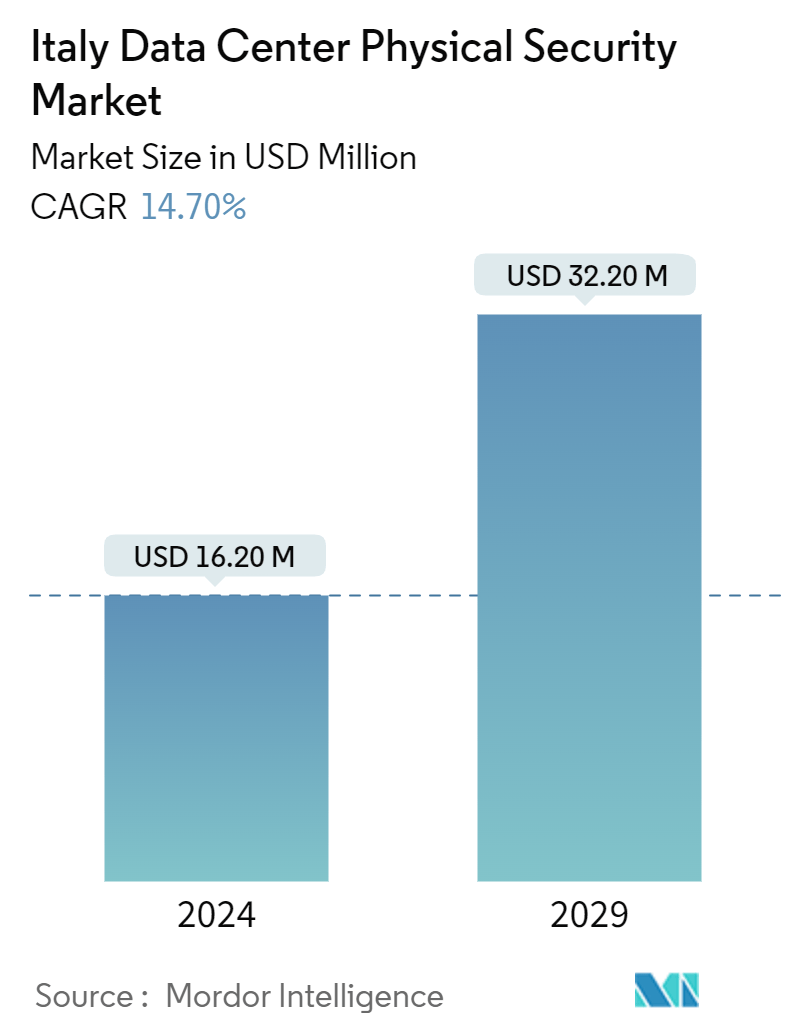Market Size of Italy Data Center Physical Security Industry

| Study Period | 2018 - 2029 |
| Base Year For Estimation | 2023 |
| Market Size (2024) | USD 16.20 Million |
| Market Size (2029) | USD 32.20 Million |
| CAGR (2024 - 2029) | 14.70 % |
| Market Concentration | Medium |
Major Players
*Disclaimer: Major Players sorted in no particular order |
Italy Data Center Physical Security Market Analysis
The Italy Data Center Physical Security Market size is estimated at USD 16.20 million in 2024, and is expected to reach USD 32.20 million by 2029, growing at a CAGR of 14.70% during the forecast period (2024-2029).
Security measures can be categorized into four layers, i.e., perimeter security, facility controls, computer room controls, and cabinet controls. The first layer of data center security discourages, detects, and delays any unauthorized entry of personnel at the perimeter. In case of any infringement in the perimeter monitoring, the second layer of defense denies access. It is an access control system utilizing card swipes or biometrics.
The third layer of physical security further restricts access through various verification methods, including monitoring all restricted areas, deploying entry restrictions such as turnstiles, providing biometric access control devices to verify finger and thumbprints, irises, or vascular patterns, providing VCA, and using radio frequency identification. The first three layers ensure the entry of only authorized people. Further security to restrict admission includes cabinet locking mechanisms. This layer addresses the fear of an 'insider threat,' such as a malicious employee.
- IT Load Capacity: The IT load capacity of the Italian data center market may grow steadily and reach above 800 MW by 2029.
- Raised Floor Space: The country's total raised floor area is expected to reach 5.4 million sq. ft by 2029.
- Installed Racks: The country's total number of installed racks is expected to reach 260,000 units by 2029. Greater Milan may house the maximum number of racks by 2029.
- Planned Submarine Cables: There are close to 32 submarine cable systems connecting Sweden, and many are under construction.
Italy Data Center Physical Security Industry Segmentation
The data center physical security market refers to the industry focused on providing products and services to safeguard the physical infrastructure and assets of data centers. This includes measures to protect data centers from unauthorized access to premises, hardware theft, vandalism, sabotage, terrorist acts, and other physical threats. Key components of data center physical security may include video surveillance and monitoring, access control systems, physical barriers, biometric authentication, and environmental controls designed to ensure the safety and integrity of the data center environment.
The Italian data center physical security market is segmented by solution type, service type, and end user. By solution type, the market is segmented into video surveillance, access control solutions, and others. By service type, the market is segmented into consulting services, professional services, and others. By end user, the market is segmented into IT and telecommunication, BFSI, government, media and entertainment, and other end users. The market size and forecast are provided in terms of value (USD) for all the above segments.
| By Solution Type | |
| Video Surveillance | |
| Access Control Solutions | |
| Others (Mantraps and Fences and Monitoring Solutions) |
| By Service Type | |
| Consulting Services | |
| Professional Services | |
| Others (System Integration Services) |
| End User | |
| IT and Telecommunication | |
| BFSI | |
| Government | |
| Healthcare | |
| Other End User |
Italy Data Center Physical Security Market Size Summary
The Italian data center physical security market is poised for significant growth, driven by the increasing demand for robust security measures to protect sensitive data. The market is characterized by a multi-layered security approach, including perimeter security, facility controls, computer room controls, and cabinet controls, each designed to deter, detect, and respond to unauthorized access. The expansion of data centers in Italy, such as the planned developments in Trento and Rome, underscores the growing need for advanced security solutions. This growth is further supported by the rising investments in the ICT sector, with cloud technologies and cybersecurity emerging as key focus areas. The government's commitment to enhancing the ICT industry through initiatives like the National Plan for Recovery and Resilience is expected to bolster the market, providing new opportunities for growth.
The competitive landscape of the Italian data center physical security market is marked by the presence of major players such as ABB Ltd, Siemens AG, Cisco Systems Inc., Schneider Electric, and Johnson Controls. These companies are actively engaging in strategic partnerships and acquisitions to strengthen their market position and expand their product offerings. Innovations like Schneider Electric's EcoCare for Modular Data Centers and the integration of Zwipe Access fingerprint-scanning smart cards highlight the industry's focus on enhancing security solutions. Additionally, the ongoing transition to 5G and the increasing adoption of broadband services are contributing to the market's expansion, as they necessitate more sophisticated security measures to safeguard data centers.
Italy Data Center Physical Security Market Size - Table of Contents
-
1. Market Dynamics
-
1.1 Market Overview
-
1.2 Market Drivers
-
1.2.1 Increasing Demand for Cloud Computing Capabilities Drives Market Growth
-
1.2.2 Increase Security Concerns in the Market Drives Market Growth
-
-
1.3 Market Restraints
-
1.3.1 The High Costs Associated with Physical Security Infrastructure
-
-
1.4 Value Chain / Supply Chain Analysis
-
1.5 Industry Attractiveness - Porter's Five Forces Analysis
-
1.5.1 Threat of New Entrants
-
1.5.2 Bargaining Power of Buyers/Consumers
-
1.5.3 Bargaining Power of Suppliers
-
1.5.4 Threat of Substitute Products
-
1.5.5 Intensity of Competitive Rivalry
-
-
1.6 Assessment of COVID-19 Impact
-
-
2. MARKET SEGMENTATION
-
2.1 By Solution Type
-
2.1.1 Video Surveillance
-
2.1.2 Access Control Solutions
-
2.1.3 Others (Mantraps and Fences and Monitoring Solutions)
-
-
2.2 By Service Type
-
2.2.1 Consulting Services
-
2.2.2 Professional Services
-
2.2.3 Others (System Integration Services)
-
-
2.3 End User
-
2.3.1 IT and Telecommunication
-
2.3.2 BFSI
-
2.3.3 Government
-
2.3.4 Healthcare
-
2.3.5 Other End User
-
-
Italy Data Center Physical Security Market Size FAQs
How big is the Italy Data Center Physical Security Market?
The Italy Data Center Physical Security Market size is expected to reach USD 16.20 million in 2024 and grow at a CAGR of 14.70% to reach USD 32.20 million by 2029.
What is the current Italy Data Center Physical Security Market size?
In 2024, the Italy Data Center Physical Security Market size is expected to reach USD 16.20 million.

